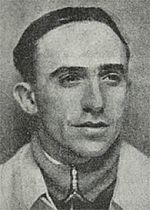Francisco Ascaso facts for kids
Quick facts for kids
Francisco Ascaso Abadía
|
|
|---|---|
 |
|
| Born | April 1, 1901 |
| Died | July 20, 1936 (aged 35) |
| Organization | Confederación Nacional del Trabajo, Nosotros |
| Movement | Anarchist movement |
| Family | Alejandro Ascaso Abadía (brother) Domingo Ascaso Abadía (brother) Joaquín Ascaso Budria (cousin) |
Francisco Ascaso Abadía (born April 1, 1901, in Almudévar – died July 20, 1936, in Barcelona) was a Spanish carpenter and an important figure in the Anarcho-syndicalist movement. He was a cousin of Joaquín Ascaso, who led the Regional Defence Council of Aragon.
Francisco Ascaso was often arrested because of his involvement in various anarchist activities and organizations. He worked closely with his friend Buenaventura Durruti. Ascaso was killed during the Spanish Civil War.
Contents
Understanding Anarchism
Around 1922 or 1923, Ascaso met Juan Garcia Oliver and Buenaventura Durruti. Together, they formed a group called Los Solidarios. They created this group after the execution of another anarchist, Francisco Ferrer. This group took action against some important leaders of the time.
Ascaso and Durruti became very close friends. They both disliked what they saw as problems with the Russian Revolution, such as too much control and false ideas.
Early Actions and Travels
To avoid the police, Ascaso and Oliver moved to Manresa. They managed to convince the police that they were just there to get papers for moving to another country. While in Manresa, Ascaso learned that Durruti had been arrested. He gathered money from Los Solidarios and went to San Sebastián to try and help Durruti, but it didn't work.
Ascaso and Oliver then decided to move to Zaragoza. There, they became involved in a plan against the Archbishop of Zaragoza, Juan Soldevilla y Romero, which happened on June 23, 1923.
Ascaso was arrested for his part in this event, but he escaped from prison with help from Durruti. In June 1923, Ascaso and Durruti left Spain and went to France. They were protesting against the government of Miguel Primo de Rivera, who was Spain's Prime Minister at the time.
Organizing in France and Beyond
In France, Ascaso and Durruti supported a group called the Revolutionary Committee. They wanted to create a center for revolutionary ideas in France. Ascaso also worked to gather supporters and weapons to help their cause.
By late 1924, Ascaso and Durruti learned that the Revolutionary Committee needed money. So, they were asked to travel to Latin America to raise funds, which they did.
They spent some time in Havana, a city in the Caribbean. There, they stayed with a young libertarian named J.A. J.A. talked with them about anarchism and encouraged them to share their ideas. Ascaso and Durruti believed that sharing their message was very important for anarchism. They soon left Havana because they worried about police attention.
In early 1925, Ascaso and Durruti sought safety in Mexico City. However, they soon left because they felt uncomfortable living in a fancy hotel while many people in the city lived in poverty. By early 1926, Ascaso traveled back to Europe, arriving in France in April.
Arrests and Deportations
On June 25, 1926, French police arrested Ascaso. He was sentenced to six months in prison because he was accused of planning actions against the King of Spain, who was visiting France. When he was arrested, Ascaso, Durruti, and another friend, Jover Cortes, were told they would be sent to Argentina.
A group called The Anarcho-Communist Union formed a committee to support their release. They held protests and hunger strikes. Even though the French government was firm at first, talks about sending them away became difficult. Eventually, the plans fell apart. On May 27, 1927, all three men were freed and sent to Belgium.
In November 1927, Ascaso and Durruti arrived in Lyon, France. In January 1928, they went to Paris to meet with Joaquín Cortés and other anarchist groups. They were quickly arrested for breaking laws about foreigners. They were sentenced to six months and were released in October 1928. They then traveled to Berlin, Germany.
In Berlin, they stayed with Augustin Souchy. A former anarchist named Paul Kampfmeyer, who had helped other anarchists before, contacted them. He wanted to help them get residency permits. While in Berlin, they constantly worried about being arrested, so they began to plan their departure. Ascaso returned to Spain by 1931.
After being sent away to Africa in 1932, he returned to Spain. He became an editor for the newspaper Solidaridad Obrera (Workers' Solidarity) and the secretary of the Catalan CNT. He supported the CNT's armed groups and did not favor political alliances with other organizations.
Role in the Spanish Civil War
During the Spanish Civil War, while living in Barcelona, Ascaso helped create the Antifascist Militias Committee. Ascaso, Durruti, and the CNT attacked army buildings and a prison ship called Uruguay. They used homemade grenades and armored cars they had put together themselves.
Francisco Ascaso was one of about 500 people who died during the attack on the Atarazanas barracks. He was buried in Montjuïc Cemetery alongside Durruti.
Legacy and Remembrance
Francisco Ascaso is remembered as a "saint" of the anarchist movement. He is also seen as a hero by the working people of Catalonia.
Personal Life
Francisco Ascaso had two brothers, Alejandro and Domingo Ascaso, who were also anarchists. They often worked together. Alejandro was born on October 17, 1889. Domingo was killed in Barcelona during the 1937 May Riots. Francisco also had a sister named Maria. In 1927, he began a relationship with Berthe Fabert. In 1924, Ascaso lived in Paris and worked in a plumbing factory, which made his breathing problems worse.
Images for kids
See also
 In Spanish: Francisco Ascaso para niños
In Spanish: Francisco Ascaso para niños




